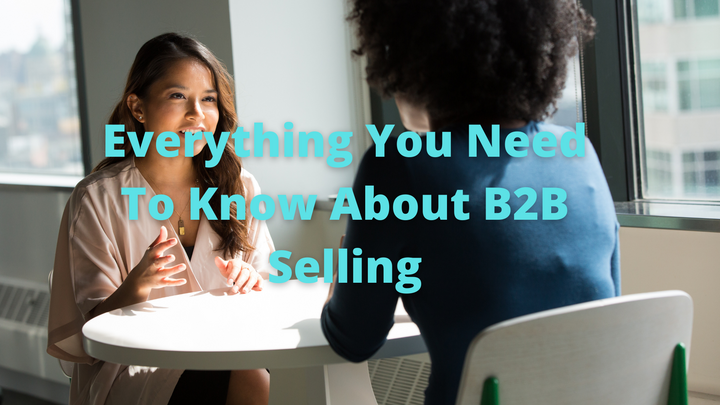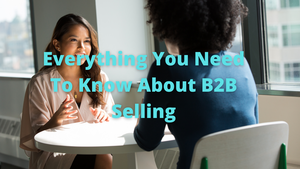Article Information
- Posted By : connexion.zone marketing
- Posted On : Apr 18, 2022
- Views : 122080
- Rates : 1
- Category : Marketing & Media
- Description : In B2B sales, analyses have shown that the average buyer goes through several stages before completing a purchase. Understand this and boost your sales!
Overview

Everything You Need To Know About B2B Selling
In B2B sales, analyses have shown that the average B2B buyer goes through several stages before completing a purchase (a ). The first stage is recognition – they recognise a problem or opportunity they have but are unaware of solutions or providers who could help them fix their problem or seize their opportunity. The second stage is research – they start researching available solutions and providers to find those that make sense for them. The third stage is evaluation – they evaluate the options they have found in order to narrow down their choices. Finally (and most importantly for a B2B sales person), the last stage is action – this is when buyers actually make contact with vendors. At this point, most buyers already know what solution fits best for them; all that’s left to do is finalise details and close the sale.
The fundamentals of B2B Sales.
A sales role is one of the most important parts of any business, and you’re going to have to deal with it every day. The concept is simple: you sell things to other people—specifically targeted products and services. B2B sales means selling leads and opportunities to products, services, or companies that are available only through a B2B buying process (think Fortune 500 companies).

The life cycle for a b2b sale can be pretty short. A company does its research and decides whether or not to implement the solution(s) in question. If they decide yes, then the sales team needs to go into action. This can include sending out cold emails or making phone calls directly, but also sitting down with your target B2B customer face-to-face and discussing how your solution will benefit them, their goals, and what they think of you as an organisation.
Your plan should align with sales, so that the can be moved through your B2B with ease, which ensures the best .A sales strategy is more than just a set of tactics.
Before you develop a sales strategy, let’s get one thing straight: A strategy is not the same as tactics. If you undertake a series of activities without a plan, it’s not a strategy—it’s just tactics.
A sales strategy is a long-term plan for how to achieve your goals. This includes understanding your sales funnel. Tactics are the actions you take to make progress toward your strategies. (In this way, they're similar to objectives.) Without strategies, there's no big picture guiding those actions or giving them meaning and purpose - think about your .
Sales psychology and persuasion are the keys to success in B2B sales.
Sales psychology is the foundation of all selling. In B2B sales, as you’ll see here, it’s even more important than closing deals.
So what exactly do we mean by sales psychology? You probably have a picture in your head of a sleazy car dealer who manipulates you into buying the lemon off his lot. That’s not what we mean.

Sales psychology is about understanding behavior and human nature. It gives you insight into your customers and their decision-making processes so that you can sell more effectively. (This will be explained more in a future article)
Logic built upon emotional engagement drives buying decisions.
The reality is that logical arguments require emotional engagement from the prospect. Without it, no matter how convincing your data and case studies are, you’ll struggle to drive a sale forward.
It’s also important to understand the emotional reasons your prospect wants to buy from you because these will help guide the direction of your logical arguments. If they need to save money but are frightened of change, for example, you can use data showing all the money they could save if they chose your product over more expensive options.

Logical arguments are most effective when they are built on emotional engagement. This means that instead of using them to overcome initial objections – which often have an emotional basis – logical arguments should be used as support for what has already been sold emotionally and validated by facts. A simple example is a person who is considering purchasing a Tesla because they want to feel like 'they're doing their part' and contributing positively to the environment but cannot justify this based on logic alone (contributing positively isn't something with an immediate ROI or other measurable benefit). Instead of trying to convince them with purely logical points such as how much tax credits add up over several years or how long it takes for reduced fuel costs to offset cost of vehicle - both great facts that highlight a pure return on investment - selling them on the story about having solar panels and enjoying being 'part of the solution' is far more powerful in this instance.
B2B sales leads make final purchasing decisions emotionally
Despite the fact that B2B sales success is rooted in logic, you'll be more effective if you can appeal to the emotional side of decision-making. And, luckily for you, emotions are contagious. That's why we recommend using a few key strategies to appeal to your prospect's right brain and “infect” them with your enthusiasm:
-
Use color to elicit emotion. Color psychology is real. Certain colors produce different feelings in people—red evokes passion, blue is calming, green means growing and moving forward—and they're not just subjective interpretations of hues: science says so.
-
Be memorable. Send a Christmas present or birthday card (or both). Connect with your prospects on LinkedIn or Twitter—it's an easy way to stay top-of-mind throughout their decision process (and it doesn't take long). This should be a part of your B2B marketing strategy and plan.
-
Give back to clients and prospects by sharing something valuable: an article, a case study from another client who has achieved success with your product/service, etc. It shows them you're focused on their success above all else and helps build trust that will make closing that much easier
Pro Tip: When creating or evaluating your , take this into consideration.
B2B sales leads need emotional validation
Emotions are the driving force behind your business, so you know their emotional needs will play a major role in your B2B sales success. To be effective at selling B2B, you must understand what they feel inside and how they want to express those feelings. You may find yourself trying to relate but not knowing how to do it in a way that makes them feel truly understood—or even valuable.
So here's the truth: no two people are alike. And that's why sticking solely to buzzwords and rational arguments doesn't work for everyone. It's only when you connect with them emotionally that you can truly demonstrate your value as a potential solution for their need or problem.

The first thing that many prospects want from salespeople is validation on their lack of confidence or emotional pain, or whatever it is they're thinking about when they're considering purchasing something from a different company over yours.
"I'm not very good at selling, but it would mean so much if someone like you could help me."
"I've never been able to get anyone else on board…"
These are all phrases we hear daily from our customers and prospects who have a hard time articulating exactly what they need help with, making them feel more comfortable talking about it (and potentially buying from us) than we do as salespeople!B2B sales leads want personalisation
You should aim to personalise every B2B sale. This includes:
-
Using your customer's name in sales conversations.
-
Tailoring your marketing tactics and content to your lead's company, industry, and location.
-
Sending price quotes that reflect the specific services or products your customer is interested in (no one-size-fits-all).
Personalisation is important because it makes customers feel they are valued as individuals, not just leads on a list. This can increase their trust in you and your product, making them more likely to convert - especially if they're comparing you against some of your fellow companies.
B2B sales leads look for expertise
One of the most important things to get right in B2B sales is demonstrating expertise. B2B leads look for a potential vendor that can help them solve a problem or make their lives easier. If you come across as an expert on your product or service, it helps build credibility and trust with the customer, but if you appear uncertain on how to fulfill their needs, they will likely look elsewhere. This starts with the right outreach, right through to closing the .
In fact, lack of expertise was the most common reason cited for switching vendors (56% of respondents). With numbers like these, it's imperative that you know your product/service inside and out so that you can confidently address any objections and reassure potential customers about what exactly you bring to the table during the .
B2B sales leads want to build trust
Trust is the most important factor in a B2B sale. If you can't be trusted, your sales leads won't close, and you won't get to the next step. Trust is earned over time and based on your ability to deliver value. But, proving that you can be trusted requires more than mere words; it requires action. At some level, every prospect wants to work with a seller they can trust. In other words, B2B sales is all about building trust—but how do you do this?
The first step for building trust with prospects is proving that you have their best interest at heart and not just trying to make a quick buck at their expense. You must prove your trustworthiness by doing the following:
-
Demonstrate that you understand your prospect's business challenges and needs (also a great technique for )
-
Deliver value before asking for anything in return
-
Showcase evidence of past successes (e.g., case studies)
B2B sales leads care more about value than pricing
It's pretty much a B2B sales 101 rule that when you're talking to leads, you should focus on value and not price. Of course, pricing can be a factor in the decision making process—but it's usually a secondary factor if they know your solution will benefit them.
The truth is, people care way more about value than they do about price. Value is comprised of many things: features and benefits, but also time and effort. For example, during the sales cycle you might realise that although your product may seem too expensive upfront—it’s actually a better deal because it saves users hours of manual work each week and ultimately increases their ROI by 10x within three years. The same applies to reporting tools: even though there are cheaper solutions out there, teams use our software because it saves them time and effort in servicing their clients (and makes them look good in front of their bosses!).
Qualifying your leads is what separates successful sellers from the pack.
Qualifying your leads is critical to a successful sales cycle. To do this effectively, you have to ask the right questions and be willing to pass on opportunities that don’t align with your offering or the buyer’s needs.
Lead qualification questions
-
What is the status of your current solution? Does it work well enough? If not, why do you continue using it?
-
How many people in your organisation currently use [your product]?
-
Do you have a budget allocated for this project? How much? Is it flexible or set in stone?
-
Who makes the final decision around purchasing this type of product/service, and how long does that process usually take from start to finish?
-
Are there other vendors/vendors you are considering for this project at this point in time? If so, who are they and what sets them apart from us (or any competitors)?
B2B selling requires fundamental sales knowledge and psychological insight into your customers
You will run into many different customers, and when you succeed with one type of B2B buyer, you may find that your approach is not going to work for someone else in a different company. If you want to build your B2B sales career, it’s essential that you understand the differences between these prospects and adapt your approach accordingly.
-
